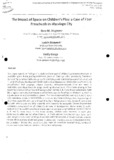Please use this identifier to cite or link to this item:
https://cris.library.msu.ac.zw//handle/11408/1380Full metadata record
| DC Field | Value | Language |
|---|---|---|
| dc.contributor.author | Mugweni, Rose M. | - |
| dc.contributor.author | Mutemeri, Judith | - |
| dc.contributor.author | Ganga, Emily | - |
| dc.date.accessioned | 2016-05-18T09:45:27Z | - |
| dc.date.available | 2016-05-18T09:45:27Z | - |
| dc.date.issued | 2012-10 | - |
| dc.identifier.issn | 2226-6348 | - |
| dc.identifier.uri | http://hdl.handle.net/11408/1380 | - |
| dc.description.abstract | This paper reports on findings of a study on the impact of children’s population density in an available space during playing traditional games in Masvingo urban preschools, Zimbabwe.Some of the common traditional games for a holistic growth and development which are played in Early Childhood Development (ECD) centres in Zimbabwe are: chitsvambe (touch and run); chuti/bhekari (ball dodging); mapere (hyenas); chihwande-hwande (hide and seek). A qualitative case study research design involving observation of 120 children playing at four randomly selected ECD centres in Masvingo urban namely A, B, C and D was undertaken. Eight (8) caregivers were also interviewed to solicit their views on the effects of children’s numbers in a given space on playing traditional games. The results revealed that centres A, B and C had a high population density and faced serious molecular and molar challenges involving shortage of play space, materials and a general lack of a play enabling environment. Centre D showed the opposite, where space and play materials were found to be adequate. Centers D promoted sustainable development in all children’s domains of development. Unlike centre D, molar variables such as social interaction and language use during playing traditional games in centres A, B, and C, were weak. In the three centers, children were crammed in small play environments which did not allow them to run freely without bumping and pecking on each other. In light of this study’s findings, it was concluded that population density had influence on the way children played traditional games in Zimbabwe. Therefore, the study recommends that low population density, ideal space and play materials should be provided at ECD centres if children are to play freely and realize sustainable development. | en_US |
| dc.language.iso | en | en_US |
| dc.relation.ispartofseries | International Journal of Academic Research in Progressive Education and Development;Vol.1, No.4; p.93.104. | - |
| dc.subject | Impact of space, children's plays, preschools, Masvingo. | en_US |
| dc.title | The impact of space on children's play: a case of four preschools in Masvingo City. | en_US |
| dc.type | Article | en_US |
| item.openairetype | Article | - |
| item.languageiso639-1 | en | - |
| item.cerifentitytype | Publications | - |
| item.fulltext | With Fulltext | - |
| item.grantfulltext | open | - |
| item.openairecristype | http://purl.org/coar/resource_type/c_18cf | - |
| Appears in Collections: | Research Papers | |
Files in This Item:
| File | Description | Size | Format | |
|---|---|---|---|---|
| the impact of space.pdf | Main article | 207.02 kB | Adobe PDF |  View/Open |
Page view(s)
188
checked on Jan 21, 2026
Download(s)
44
checked on Jan 21, 2026
Google ScholarTM
Check
Items in MSUIR are protected by copyright, with all rights reserved, unless otherwise indicated.



